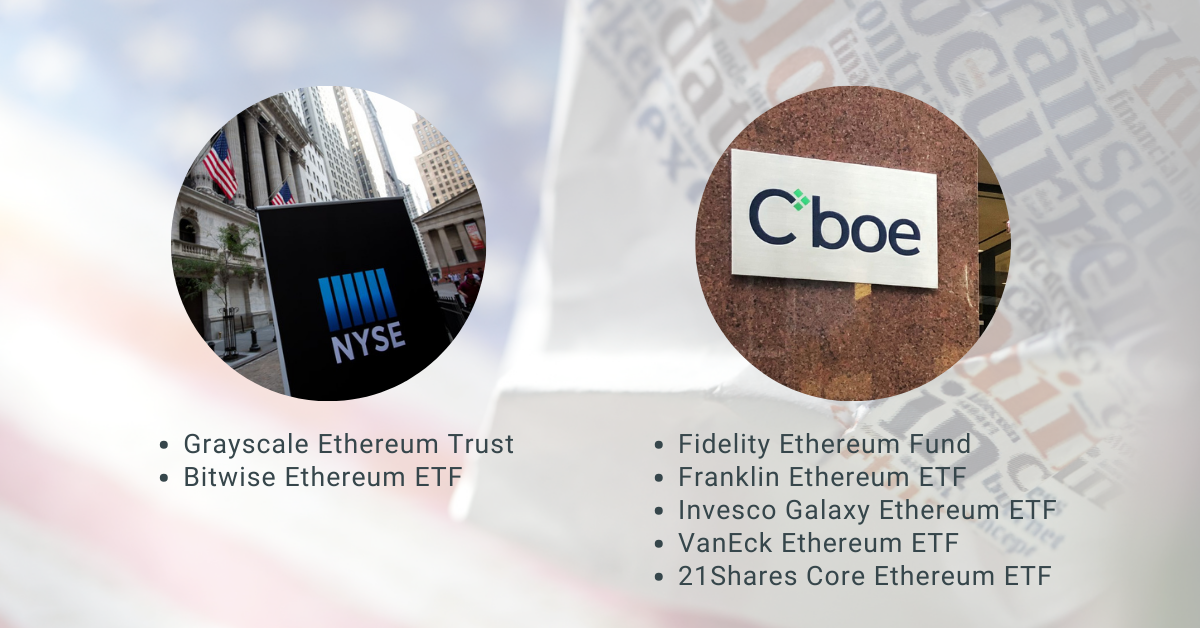SEC Officially Approves Ethereum Spot ETFs
SEC has officially approved several Ethereum exchange-traded funds (ETFs) to start trading on July 23rd. ETFs (Exchange Traded Funds) are investment funds that track the performance of a specific index or bond. The approved Ethereum ETFs include those from 21Shares (CETH), Bitwise (ETHW), BlackRock (ETHA), Fidelity (FETH), Franklin Templeton (EZET), VanEck (ETHV), and Invesco Galaxy (QETH), all set to begin trading on July 23rd.
JUST IN: 🇺🇸 Ethereum ETFs to start trading tomorrow. pic.twitter.com/fXSafTrkZ8
— Radar🚨 (@RadarHits) July 22, 2024
However, the Grayscale Ethereum Mini Trust (ETH) and Grayscale Ethereum Trust (ETHE) have yet to receive official approval documents from the SEC, but market observers predict they will be approved soon.
This marks a significant milestone for Ethereum and the broader cryptocurrency industry. Listing these ETFs is a game-changer for Ethereum, allowing investors to access the world’s second-largest cryptocurrency without directly holding it. It also brings a positive shift to the crypto market, surrounded by negative news lately.
Applications for Ethereum ETFs began in May 2021, but the SEC initially rejected them, citing concerns over the potential manipulation of Bitcoin and Ethereum ETFs. However, since the introduction of Bitcoin ETFs in January 2024, the focus has shifted to Ethereum ETFs. In recent months, the SEC has dramatically changed its stance. They went from remaining silent and threatening to investigate ETH as security to giving preliminary approval to 8 Ethereum ETF proposals within a few days in mid-May and finally requesting issuers to complete their filings for today’s official approval.
The approved Ethereum ETFs will be listed on the Chicago Board Options Exchange (CBOE) and the NYSE Arca platform. They will be backed by Bitcoin purchases from cryptocurrency exchanges under the supervision of specialized entities like Coinbase Global.

This setup aims to create a market surveillance mechanism to prevent Ethereum price manipulation and reduce transaction fees to 0.15-0.25%, except for Grayscale’s ETHE fund, which has an annual management fee of up to 2.5%. This fee is significantly lower than the average transaction fees in the general ETF market. Additionally, investors will benefit from an initial fee-free period ranging from 6 to 12 months when trading Ethereum.

Positive Signals Surround Ethereum ETFs Officially Trading
Buying Ethereum ETFs in spot form allows investors to trade Ethereum without the risks associated with directly holding the cryptocurrency. Traditional cryptocurrency transactions involve setting up wallets and accounts on exchanges, which often have poor security and are vulnerable to hacking.
Additionally, Ethereum ETFs listed on regulated stock exchanges provide access to a wide range of investors, from minor to large-scale, while minimizing the chances of scandals like the FTX crisis or recent money laundering and price manipulation incidents involving Binance.
To compare, spot Bitcoin ETFs attracted nearly $5 billion on their first trading day, January 11th. This was impressive compared to the $3 billion experts initially expected. The introduction of spot Bitcoin ETFs also significantly boosted Bitcoin’s price, pushing it past $49,000. Over the first half-year of trading, Bitcoin ETFs have seen an inflow of $16.1 billion, with sustained positive inflows.
A recent study by Citigroup predicts that Ethereum ETFs will attract between $4.7 billion and $5.4 billion in the first six months of operation. Although this is 70% lower than Bitcoin ETFs achieved in their first six months, it still promises to boost the world’s second-largest cryptocurrency substantially.
What Investors Should Know After SEC Approval of Ethereum ETFs
Some analysts warn that the “hype” around the launch of spot Ethereum ETFs might lead investors to make unwise decisions.
One of the most critical factors for investors to consider is the funds’ fees, their liquidity, asset levels, and the ability to track the spot price of Ethereum closely.
Pay attention to the liquidity of spot Ethereum ETFs. High liquidity ensures that you can easily buy or sell ETF shares without difficulty. This is especially crucial in volatile markets where prices can change rapidly.
ETFs with high liquidity often trade close to their net asset value (NAV). This means you are buying or selling ETFs at a price that accurately reflects the value of the fund’s assets.
Lastly, investors should avoid rushing into Ethereum investments out of fear of missing out (FOMO). Instead, they should be honest about their reasons for entering the market and only invest money they are willing to lose. In a diversified portfolio, exposure to Ethereum should be between 1% and 5%, with 2% being considered the most reasonable.
With the approval of spot Ethereum ETFs, investors should approach this new opportunity cautiously. Rather than jumping in or dismissing it outright, stay informed and maintain a flexible, open-minded approach. Assessing market dynamics, potential risks, and the regulatory environment are crucial factors.








